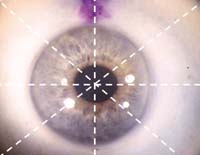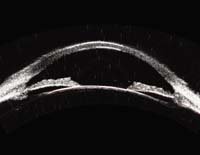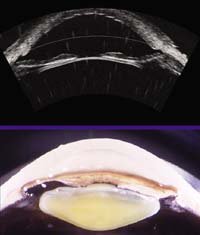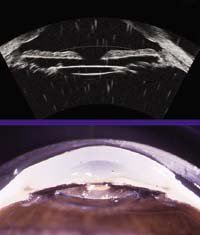High-frequency ultrasonography clears up old misconceptions on phakic IOL sizing
According to ultrasound analysis of postmortem specimens, the eye is not perfectly round, and white-to-white measurements are unreliable.
ROME – Evaluation of the geometry of the anterior chamber and ciliary sulcus using a high-frequency ultrasound system demonstrated that the eye is not geometrically round, as the measurements taken at different meridians do not coincide, a speaker here said.
“Although the difference between meridians is relatively small, it may be significant enough to explain the postoperative rotation we can observe with some phakic IOLs. It is also important to evaluate if these differences are significant enough to be taken into account by IOL manufacturers to improve the design and sizing of phakic IOLs,” said Liliana Werner, MD, PhD, at the winter meeting of the European Society of Cataract and Refractive Surgeons.
A second important finding, confirming the result of other studies on this subject, was the lack of correlation between ultrasound sizing of the anterior chamber and ciliary sulcus diameter and the white-to-white measurement based on empiric formulas.
Taking measurements
|
As phakic IOLs gain popularity, the problem of sizing has become crucial. Most major complications of these implants are related to incorrect sizing.
“If the white-to-white measurement has proved by experience of many surgeons to be unreliable, other methods, like the various intraocular measuring devices that can be inserted into the anterior chamber during surgery, cannot be the answer. They might give slightly better results, but they are a rather invasive method,” Dr. Werner said.
In her study, conducted at the David J. Apple, MD Laboratories for Ophthalmic Devices Research (John A. Moran Eye Center, University of Utah), in collaboration with Drs. Suresh K. Pandey and Andrea M. Izak, an ultrasound system was used to scan cadaver eyes, obtain a series of measurements and look for correlation between them.
The system used was the Artemis (Ultralink), an anterior segment B-scan digital system with very high frequency (50 MHz), developed at Cornell University by D. Jackson Coleman, MD, R. Silverman, MD, and Dan Z. Reinstein, MD.
“We used 10 phakic and 10 pseudophakic human eyes obtained postmortem from eye banks. We measured the anterior-posterior length of the eyes and the white-to-white in the vertical and horizontal meridians with surgical calipers. Then the eyes were fixated in a special holder and underwent ultrasound examination,” Dr. Werner said.
Four meridians were evaluated in each eye: vertical, horizontal and two oblique (at 90°, 180°, 45° and 135°). The scanning at each meridian resulted in an image of the anterior segment at that point. Then, the measuring tool incorporated in the Artemis measured the anterior chamber diameter and the ciliary sulcus diameter in each image.
Measures do not match
|
“When we compared the measurements of the anterior chamber diameter in different meridians, we found a difference that was statistically significant. The same applied to the diameters of the ciliary sulcus,” Dr. Werner said.
“Also, when we looked at the correlation between the white-to-white and the anterior chamber and ciliary sulcus diameters, we found a positive correlation in this series between the white-to-white and the anterior chamber diameter only in the vertical meridian. We couldn’t find the same correlation in the horizontal meridian, and there was no correlation at all between white-to-white and ciliary sulcus diameter in either the vertical or horizontal meridian,” she said.
Although the eyes used in the study were carefully selected, and deformed or collapsed eyes were not included, some postmortem changes always occur, which could slightly alter the accuracy of results.
“It will be eventually interesting to confirm our results by studying patients in the same way,” Dr. Werner said.
However, the study suggests that the human eye is not perfectly round, and that the traditional methods used so far for IOL sizing are grossly inaccurate, two crucial aspects we have not been fully aware of for so many years, she added.
“Finally, we believe the ultrasound system used is a valuable means of IOL sizing, as it provides accurate, objective measurements of the internal diameters of the eye. Another advantage is that it is also noninvasive, and measurements are taken preoperatively, giving time for a careful evaluation of the size and type of IOL to be used for each patient,” Dr. Werner said.
For Your Information:
- Liliana Werner, MD, PhD, can be reached at John A. Moran Eye Center, 5th floor, 50 North Medical Drive, Salt Lake City, UT 84132; (801) 581-8136; fax: (801) 581-3357; e-mail: liliana.werner@hsc.utah.edu.




